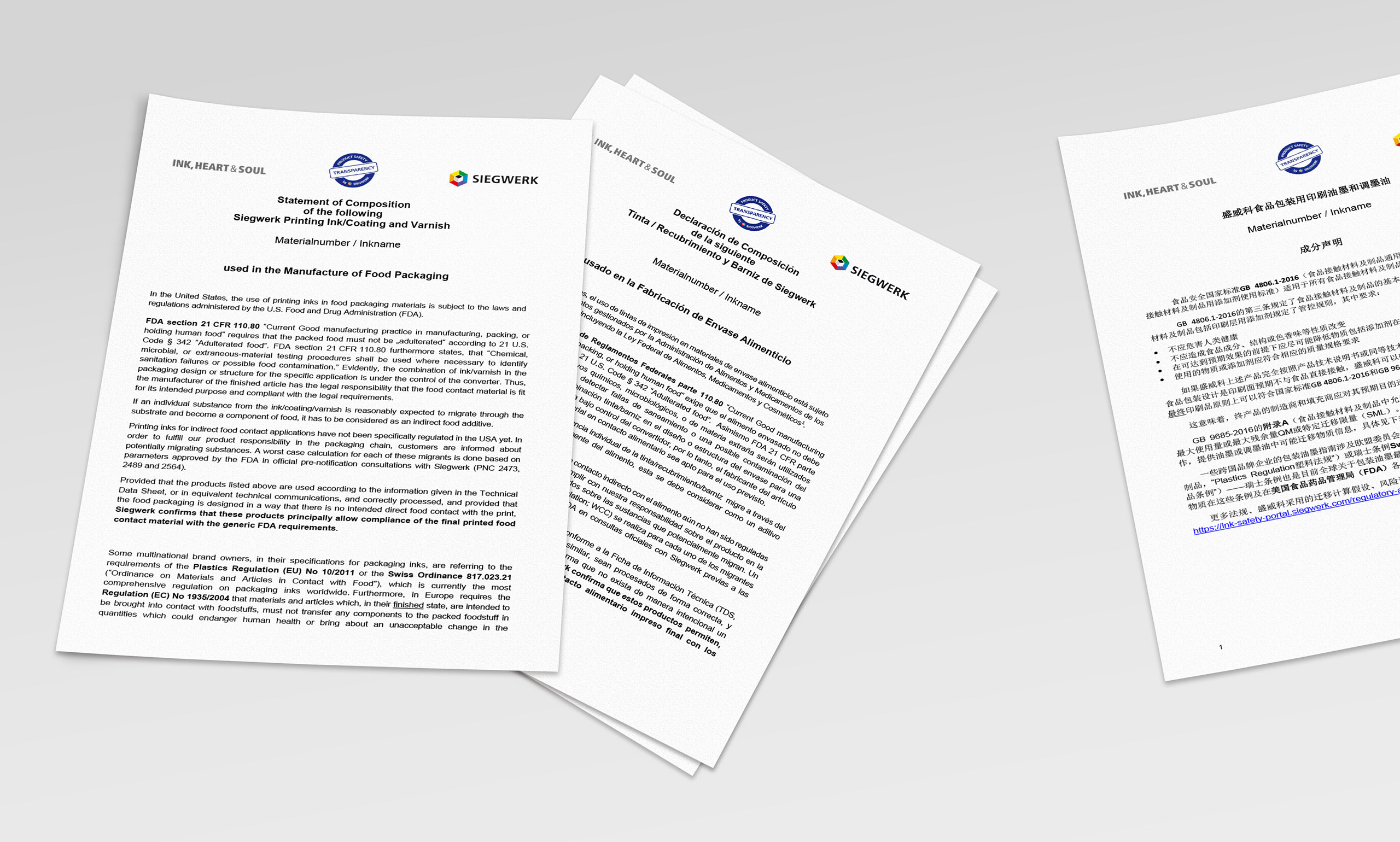Statement of Composition (SoC)
At Siegwerk, we provide information on potentially migrating substances present in our inks via a Statement of Composition (SoC), in order to allow our customers the evaluation of migration from their individual printed food packaging structure. These SoC’s are in line with EuPIA (European Printing Ink Association) recommendations, are based on current regulatory frameworks and are generated automatically from our SAP system.
Depending on the relevant region of applicability, individual templates with specific information about the listing status of the migrants are available:
EMEA
For the European market, the regulatory base for the Statement of Composition is the “Framework Regulation” (EC) No 1935/2004 on materials and articles intended to come into contact with food. Possible migrants are listed with their Specific Migration Limits (SML) according to the “Plastics Regulation” (EU) No 10/2011, the Turkish Food Codex Regulation (Tebliğ No 2019/44) and the Swiss Ordinance SR 817.023.21 (Annex 2 or 10). Furthermore, an information will be provided if the migrant is a “dual use substance”, this means is also authorized as food additive by Regulation (EC) No 1333/2008 or as flavoring by Regulation (EC) No 1334/2008.
CUSA
In the USA, the regulatory base is FDA section 21 CFR 110.80 “Current Good manufacturing practice in manufacturing, packing, or holding human food“ which requires that the packed food must not be „adulterated“ according to 21 U.S. Code § 342 “Adulterated food”. In the CUSA template of the Statement of Composition all potentially migrating substances are reported to assist members of the food packaging chain to make informed decisions in their packaging compliance. Moreover, the listing in a respective FDA chapter is given for information purposes as well as the listing status in the Regulation (EU) No 10/2011 and the Swiss Ordinance SR 817.023.21.
LATAM
For the Mercosur market, the regulatory base for the SoC is the GMC “Framework Resolution” N° 03/92. In the template, the listing status of all potentially migrants in GMC MERCOSUR RES. N° 02/12 and GMC MERCOSUR RES. N° 39/2019 is provided.
INDIA
The Indian Standard IS 15495:2020 “Printing Ink for food packaging – Code of practice” has been developed by the Bureau of Indian Standards and prescribes guidelines for printing inks for the use on food packages. In the corresponding SoC template an information about the listing status of all potentially migrants in the Regulation (EU) No 10/2011, the Swiss Ordinance SR 817.023.2 as well as the Regulations (EC) No 1333/2008 and (EC) No 1334/2008 for “dual use substances” is provided.
CHINA
In China, the National Standard GB 4806.1-2016 (“General Safety Requirements of Food Contact Materials and Articles”) applies to all Food Contact Materials and Articles. In the corresponding SoC template the listing status of all potentially migrants in the National Standard GB 9685-2016 (“Standard for Uses of Additives in Food Contact Materials and Articles”) is provided and furthermore an information about the listing status in the Swiss Ordinance SR 817.023.2, the Regulation (EU) No 10/2011, the FDA chapters and the Regulations (EC) No 1333/2008 (EC) No 1334/2008 for “dual use substances”.
GLOBAL
For an overview about the potentially migrating substances and their listing status in the above mentioned regulations of the different regions, a global template of Siegwerk’s Statement of Composition is available on request.
Furthermore, due to different applications and printing technologies, special SoC templates are available on request:
- NFI (Non-finished ink): For inks/varnishes where the converter combines at least two products in order to obtain a finished ink/varnish (e.g. Masterbatch system, 2K system)
- UV: For UV curing inks/varnishes (only after signing a valid NDA)
- DFC: For Direct Food Contact applications
Commitment to transparency
Additionally, Siegwerk’s Statement of Composition gives an information about the maximum amount of the migrant within the dried ink film. This allows our customer to perform a worst case calculation taking into account own printing parameters as well as the real packaging structure. Moreover, the Statement of Composition offers results of worst case calculations for these migrants, based on specific worst case conditions:
- EMEA, LATAM, INDIA, CHINA, GLOBAL:
EU-Cube (6 dm2/1 kg food) or - CUSA: FDA conditions (1 in2/10 g food)
- 3 g/m2 dry ink deposit
- 100 % surface coverage
- 100 % migration
Siegwerk is committed to disclose all information to our customers that is necessary for the identification and quantification of intentionally added (IAS) as well as non-intentionally added (NIAS) substances, which are relevant for migration. Click through the graphic below to learn more about the general structure of our Statement of Composition, using an exemplary SoC for the European market.

Below you can find 3 examples of our Statement of Composition from other regions in the world

